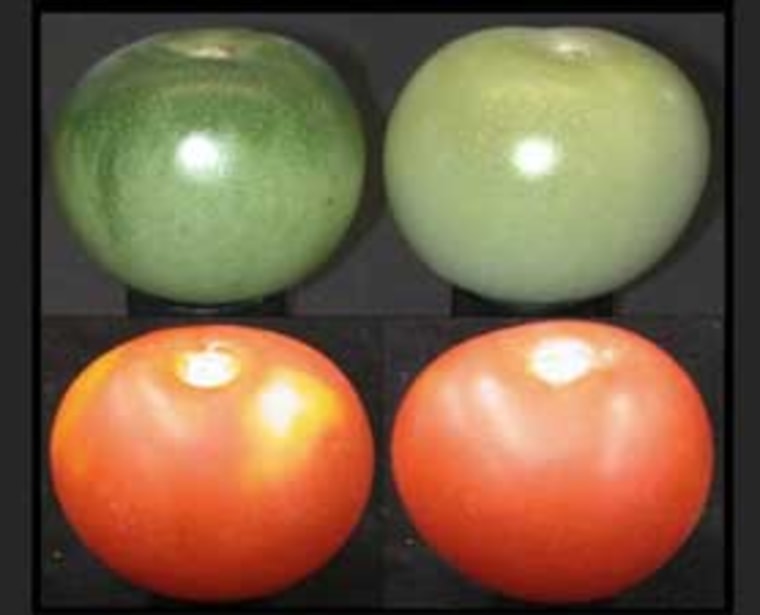Most supermarket tomatoes are flavorless at best, and a single gene mutation goes a long way toward explaining why.
The mutation arose as breeders cultivated tomatoes to ripen evenly, a trait that makes harvesting cheaper and more efficient. As pretty as they look, though, mutated tomato fruits are less efficient at photosynthesizing, found a new study. As a result, they make less sugar and other compounds, which means they often taste far worse than tomatoes that may look blotchy but are full of explode-in-your-mouth sweetness.
For consumers who like their Caprese salads rich and complex, the results suggest that, for now, heirloom varieties at co-ops and farmer's markets may be your best bet. Eventually, the findings could help breeders put more satisfying flavor profiles back into everyday grocery store tomatoes.
NEWS: Grocery Cart Suggests Better Food Choices
"When you have fruit or berries and you sprinkle sugar on top to accentuate the flavors, you can see how every little bit helps," said Ann Powell, a biochemist at the University of California, Davis. Our sensitivity to sweetness makes a gene for sugar production extra-important. "By knowing which gene it is, breeders can now select for varieties when plants are young."
For some 70 years, tomato breeders have worked to create fruits that are uniformly light green before they ripen. The advantage of this even coloring is that fruits become ripe all at once, instead of at the top end first. That makes it much easier for farmers to tell when it's time to harvest.
Motivated more by the question of why tomatoes bother being green in the first place than by the question of why tomatoes so often taste terrible, Powell went on a hunt for proteins inside the fruit called transcription factors, which direct the genes that code for various traits.
VIDEO: Why does fruit turn brown?
That search led her to a type of protein in tomatoes called GLK. When intact, she and colleagues reported Thursday in the journal Science, the protein makes pre-ripened fruits appear dark green at the shoulder, where flesh meets stem. With the mutation, on the other hand, fruits are light green all over before they turn red.
Scientists have known for a long time that two GLK proteins in the leaves of tomato and other plants direct the production of chloroplasts, which are responsible for photosynthesis, turning sunlight into sugars, and some of those sugars travel into the fruit to add sweetness.
Now it appears that the fruits of tomato plants also contain a GLK protein, which boosts sugar production just enough to make a real flavor difference. The dark green shoulder is a sign that extra photosynthesis is happening. Chemical analyses showed that tomatoes with normal GLK proteins also contained more lycopene, an antioxidant that gives tomatoes their red color.
HOWSTUFFWORKS: How to Pick Ripe Fruit
Once tomatoes turn red, though, it becomes impossible to tell which fruits have the mutation, making it highly unlikely that a supermarket shopper would be able to pick out tomatoes with naturally higher levels of sugar.
In fact, the chances of unmutated tomatoes showing up in any major grocery store are extremely slim. When Powell and colleagues looked at 25 commercial varieties of tomatoes from all over the world, they found the exact same mutation in all of them.
"The mutation they describe in their paper is in literally 100 percent of modern breeds sold in grocery stores today," said Harry Klee, a molecular geneticist at the University of Florida, Gainesville, who studies the chemistry and genetics of flavor in fruits and vegetables. "It's a really good illustration of some of the problems with modern breeding of tomatoes."
The GLK mutation isn't the only reason why supermarket tomatoes are so often tasteless, Klee added. But it's an important reason, and it demonstrates how focusing on aesthetics can end up sacrificing other important qualities in an entire generation of produce.
"When you focus on one thing and neglect the other — the other being flavor — you can have some really bad unintended consequences," Klee said. "The consumer is going to have to realize that their tomatoes may not look perfect. There may be a patch of green around the top of the fruit. But to me, I would say, if I see that a fruit is not perfectly red and perfectly uniformly ripened, maybe it's going to taste better."
